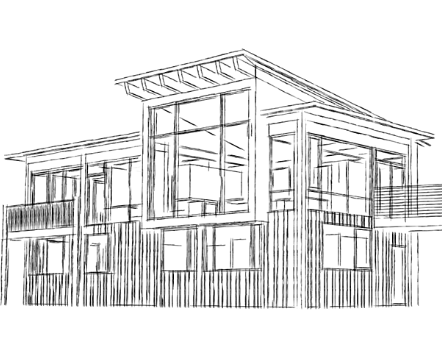Architecture
If there is one stage in the project where to put energy, it is in the design, in the preparation. This is where your project will take shape. It is also this decisive step where the project budget is played out. Only good planning can achieve your goals.
Define your priorities
It is when it is conceived that the project can really begin to take shape.
Before starting the designs for your house, it is important to take a step back to define your vision and who will serve this building. To set your priorities, consider making a list of your needs and a list of your wants. This will help you make some decisions. To be clear: a need is a non-negotiable item. Without it, the project is not even worth doing. As for a desire, or a wish, it is an element that we want to integrate into our home, but which is not absolutely essential or which can be considered for the longer term.
The purpose of the exercise is also to define your priorities for your project. Of course, the priorities can be multiple, but it is useful to have a relatively orderly list of them, in order to ensure that you stay consistent with what for you is the heart of your project. Some examples of priorities: a healthy home; a house with as little maintenance as possible; a project that will above all have a reduced impact on the environment; a house that saves water and energy; habitat to promote food self-sufficiency. Do you want to put forward a certain design, a certain view that you have from your land? Or, do you care about resale value ..? By prioritizing your project, you make sure you stay focused on what matters to you - the essence of the project.
Integrated design
Integrated design is a transversal working method, in which a whole multidisciplinary team works together around the same project. The goal is to put everyone's expertise to good use to create the best possible project, taking into account all points of view: designer, technologist, estimator, carpenter, specialist in mechanics and systems... And at the center of it all, is finds the customer, bearer of his own vision and future inhabitant of the place of life which is being created. The members of the team are there to guide him, support him, share their expertise with him.
It also makes it possible to anticipate challenges, and in the case of construction, to properly plan the site.
The integrated design contrasts with the "silo" design, which has more as a credo than "to each case, its expert" and this, chronologically. Typically, a silo house project consists of the development of plans by a designer, followed by a step of requesting quotes from contractors. With generally, additional costs not foreseen in the key.
To properly prepare a project, you have to combine expertise and create a dialogue between stakeholders, who each have a different perspective. Each of their decisions will be linked to the other person's decision. And also, each decision can have an influence both on the nature of the project and on its budget.
At Belvedair, we only work in integrated design. The designers' point of view is matched by the budget follow-ups of the estimators. Technologists and carpenters are called upon for their technical and pragmatic perspective. The energy efficiency expert guides you in the heating and mechanical choices available to you. As for the project managers, they orchestrate everything, answer your questions, document the project, coordinate the external stakeholders (surveyors, ground technicians, etc.) and ensure that your project remains faithful to your vision.
An excellent motivation for the whole team is that by dialoguing in this way, we create balanced, viable, beautiful and functional projects, which will not stay in a drawer.
In other words, by bringing together all areas of expertise under one roof, Belvedair ensures cohesion in all decisions taken, which is reflected as much in the quality of the service as in that of the final product. And you are the one who benefits!
Sizing
Optimize spaces and functions
 Any new building must be well sized. This implies in the first place, optimizing the square foot. Indeed, this is what has the most impact on the environment: an optimized home will require less materials, less costs, and less maintenance afterwards. To optimize the areas, you have to play with a few tips:
Any new building must be well sized. This implies in the first place, optimizing the square foot. Indeed, this is what has the most impact on the environment: an optimized home will require less materials, less costs, and less maintenance afterwards. To optimize the areas, you have to play with a few tips:
Define your lifestyle and needs
Avoid corridors and wasted space, which in the process also provides a better feeling of space... in other words, you breathe!
Think of rooms as multipurpose spaces, instead of planning "one use per room". For example, can your office be a guest room? Can your workshop have a storage section…? Everyone has their answers, according to their way of life.
You have to think of the house at its base to be ecological, and not try to arrange a plan to make it ecological ... doing this is more efficient. In addition, we go further in this way, and at a lower cost. The roof is the perfect example of this principle. By avoiding superfluous gables, hooks and skylights, we make it simple and durable: less joints ("valleys"), less complexity, less risk of infiltration or accumulation of water, ice, etc. simplifying the shape, we simplify the installation: fewer cuts, less labor time... By simplifying, we can afford to install sheet metal, which will be much, much, more durable than shingles. 'asphalt. Thinking about the simplicity of a roof is a winner at all levels.
In the same way, we will seek to create more square or rectangular buildings, rather simple, because each junction brings its share of challenges to insulate and waterproof, in addition to multiplying the amount of material needed to build.
Projects in phases
Good sizing can also mean thinking about the project in phases. Basically, a questioning: do you prefer a more expensive but "all-inclusive" project from the start, even if it means waiting a few years for the budget to be more secure? Or do you prefer to take action with a project that is initially smaller, but planned to evolve over time? Everyone has the answer for their own project, but the question is worth asking.
If your project costs too much on Day 1, the solution may be to take it in stages. We also talk about an evolutionary house, or a phased design. Some examples: add the garage or the carport later, plan a greenhouse but plan it in a few years, do not finish the basement right away, or even plan a habitable attic to be finished later ... already these unfinished spaces, even uninsulated, in phase 1, this prevents you from having to excavate again in the future, opening the exterior facings, attaching roofs, and all other costly and energy-consuming interventions.
The advantage of an evolving home is that you are already taking action to live in the living space of your dreams. Phase 1 fills your current needs, and you can over time enhance your new habitat.
Passive solar design
What is "Passive Solar"?
Passive solar energy involves letting the heat of the sun enter the house through the windows. The goal is to take advantage of the free energy that the sun sends to us, day after day. The sun sends us a phenomenal amount of energy, which we must seek to design and implant the house.
In a passive solar house, the energy thus captured is stored in materials capable of absorbing heat, integrated into the house, such as for example brick, concrete, plaster, thicker gypsum, ceramics, etc. These materials have the advantage of being able to store a large amount of energy during the period of sunshine and can thus prevent overheating. They can then retransmit the heat accumulated to the house during the night. However, while the choice of materials is one of the key elements of passive solar, in the climate we live in, it pays to add a lot. A light dosage is more than enough and your home will not need to have all the "good student" materials to be a fabulously comfortable place.
What to plan?
The design and choice of location are the most decisive factors in considering the principles of passive solar. From the first field visit, the goal is to see what is the course of the sun in relation to the ground? Where is the East, where the sun rises; the South, where it spends the day, and the West, where it sleeps.
We can thus position the rooms of the house and the windows to benefit from them. Ideally, we position a ratio of 60% of windows in the South, because this is where the sun is the most interesting, and we will seek between 15 and 20% in the East or in the West, and in the North, we try to put the minimum.
Of course, these ratios are the theoretical ideal, since in reality you have to adapt to each terrain.
Another element to consider for passive solar: the difference in inclination between winter and summer. In summer the sun is much higher than in winter. In winter and between seasons, we will leave the rays low, enter the building far: because it is this energy that will do without mechanical heating, a large part of the time, in these seasons when standard houses have it. need. Conversely, in summer, the rays are high and it is hot, so we will rather try to block the direct sun with eaves or sun shades. This will limit the need for air conditioning.
To obtain a passive solar house, it is therefore important to carefully plan its orientation, the size of its roof overhangs, as well as the size and positioning of its windows, the layout of the rooms, etc. be careful to plan it well. We will also be vigilant with the levels of insulation and waterproofing, as explained in the third step, otherwise the heat captured during the day will quickly leave the house in cold weather.
On a daily basis, the principles of the passive solar house therefore translate above all into a lot of comfort, light, and heat when you need it.






